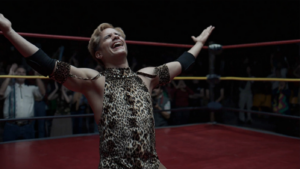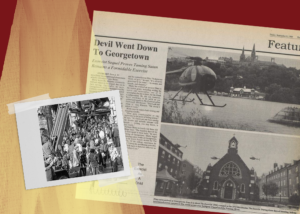With its cobblestone pathways, rainbow townhouses, and stunning gothic architecture, Georgetown is nothing short of cinematic. While many spots have garnered filmmakers’ attention over the years, the precipitous stone steps connecting M and Prospect Streets NW are by far the most iconic movie site in the neighborhood. Known as “The Exorcist Steps,” this ominous staircase nestled in the crook of Car Barn’s shoulder has become a fixture of local culture as well as a popular tourist attraction. That notoriety is largely due to the success of its namesake film, which celebrates its 50th anniversary this year.
Based on William Peter Blatty’s 1971 novel of the same name, director William Friedkin’s 1973 film adaptation of The Exorcist follows Regan (Linda Blair), a 12-year-old girl who becomes possessed by an evil spirit after her mother (Ellen Burstyn) moves their family to Georgetown. Securing 10 Oscar nominations—including one for Best Picture, a first for the horror genre—and two wins in 1974, the film brought critical recognition to horror as a whole. It also spawned several spinoffs including two sequels, two prequels, and a reboot film released just this month: The Exorcist: Believer. Needless to say, the film boasts quite the legacy.
Like Regan, I too felt overtaken by a spirit while watching this film—school spirit, that is. As a current student at Georgetown University, when the first shot of Key Bridge against the skyward-stretching Healy spires rolled, a sense of delight washed over me. Watching the movie-within-a-movie filming scene with Hoyas sardined on the steps of Healy Hall and criss-crossing on the lawn’s lattice paths, it’s hard not to imagine the similarities and divergences between their Georgetown experiences and mine. After all, for every recognizable shot of campus’s more static fixtures like Gaston Hall, Dahlgren Chapel, and the Lau stairs, there is a scene of students playing on tennis courts where Village A stands today or a shot of Harbin Hall with a wildly different surrounding landscape. For anyone who has ever called Georgetown’s campus home, watching The Exorcist feels like opening a precious time capsule, making for a viewing experience that simultaneously warms the heart and sends shivers up the spine.
Though it might be perplexing that such a bleak tale became so beloved, the film’s masterful execution of its simple premise catapulted it to legendary status. By maintaining a tight narrative scope and crafting a bone-chilling atmosphere free of trite gimmicks, Friedkin’s film is truly something spectacular.
After playing with a Ouija board, Regan begins demonstrating erratic, violent behavior that doctors are unable to explain. Eventually, her mother Chris realizes Regan needs more than a doctor—she needs a priest. Her mysterious condition is thanks to “Captain Howdy,” the demon Pazuzu (Mercedes McCambridge) who seizes control of Regan’s body. Chris enlists the help of Father Damien Karras (Jason Miller) to rid Regan of the evil inside her.
Much of the film’s enduring brilliance stems from its methodical pace. Many modern horror films clutter their runtimes with cheap jumpscares which use obnoxiously loud sounds to coax the viewers’ fear like a flashing “APPLAUSE” sign. In contrast, The Exorcist is a delectable slow burn that authentically earns the audience’s anxiety by letting its disquieting premise speak for itself. The slow yet steady escalation of Regan’s possession is genuinely unnerving—not a jump-out-of-your-seat fright, but a compelling, sustainable scare. Whenever Pazuzu has a flare-up, rather than startling the viewer straight into the action, Friedkin methodically builds up to the fit’s most terrifying elements, nurturing our attention rather than desperately grasping for it.
Bolstering the horror of these moments are the impressive special effects that have withstood the test of time remarkably well considering filmmaking technology’s drastic evolution over the past half-century. The unsettling flashes of Pazuzu’s agonized face and Karras’s deceased mother staring hollow-eyed into the camera are truly bloodcurdling. When an invisible force scratches “help me” from underneath the skin of Regan’s stomach, the visual’s authenticity allows you to focus on the dread of the moment: an innocent girl is trapped inside her own body. Regan’s makeup also convincingly communicates her anguish—from her flaky, cracked lips (Let’s get this poor girl some Chapstick, please!) to her scarred, pale face and striking green contacts, her physical transformation is sickening. Her iconic levitation scene is equally stupefying—a true feat for its time. As many older movies look increasingly outdated, the visuals of The Exorcist remain a source of pride rather than an anachronism to be excused away.
Superb acting performances reinforce the film’s immersive nature; Burstyn, Blair, and Miller all received Academy Award nominations for their work, and for good reason. Miller imbues Karras with a noble softness, balancing out Burstyn’s palpable rage. Blair, however, is easily the film’s strongest link, as evidenced by her win for Best Supporting Actress at the 1974 Golden Globes. Considering her young age and the centrality of her character, her performance was essential to the film’s immediate and perennial success. Despite the mature, vulgar material the role forced her to grapple with, Blair embodies Regan’s possession with tact far beyond her years, masterfully cycling between moments of despondency, terror, and aggression.
The Exorcist received similar praise for its sound design, with Robert Knudson and Christopher Newman winning the Oscar for Best Sound. With a piano trill, twinkling bells, and a slinking bassline, the main theme underscoring Chris’s walk around the Georgetown neighborhood creates a sublimely spooky mood. When juxtaposed with eerie, suspenseful quietness, these sparse musical interludes capture your full attention.
While the landscape of both Georgetown and the horror genre have changed drastically since The Exorcist’s debut, the film defiantly stands the test of time. It doesn’t simply hold up—this film continues to be a stand-out within the horror genre, setting a high bar for successors, which few have been able to reach, much less surpass. Even removed from the horror category, this film earns its genre-defying classic status by telling a straightforward story to the very best of its abilities, ensuring this tale will continue to haunt our screens for many more years to come.






What an insightful and finely-written essay on “The Exorcist” by Ms. Wharram! I only wish my father were still around to read it himself. I know that he would have been as impressed as I am. This is one of the best commentaries on the film that I have read in the 50 years since its release. I think Ms. Wharram has a brilliant future ahead of her!
Mr. Blatty, I am incredibly honored that you read and enjoyed my review of “The Exorcist.” It was an absolute privilege to write about this historic film which means so much to the Georgetown community! Thank you so much for your kind words. Wishing you all the best! Go Hoyas!